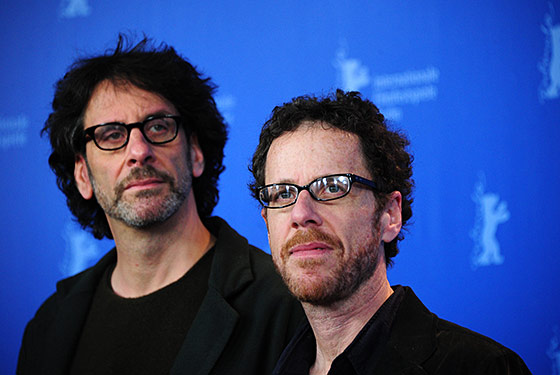
Sure, you loved Fargo; you can quote entire passages from The Big Lebowski ÔÇö ÔÇ£I do mind; the Dude minds. This will not stand, ya know, this aggression will not stand, man.ÔÇØ ÔÇö but telling Joel apart from Ethan? Even the biggest Coen brothers fans can have difficulty with that.
Since the pair are up for Best Picture and Best Director once again this year for True Grit, thereÔÇÖs a chance (albeit an outside one) that theyÔÇÖll be stepping up to the Oscar podium once again on Sunday. So to avoid confusion, Vulture tracked down one of the Coen brothersÔÇÖ earliest childhood friends and cinematic collaborators to help us understand the differences between Ethan and Joel ÔÇö both on-screen and off. Mark Zimering, originally of St. Louis Park, Minnesota, (and known to the Coens as ÔÇ£ZeimersÔÇØ), appeared in early Super 8 Coen amateur films like Zeimers in Zambezi (1970) and Lumberjacks at Play (1971).
To judge from what Zimering told us, the Coens are complementary opposites in many ways ÔÇö Ethan is the archetypal quiet one, and the dialoguist, and Joel the more outgoing visualist. As such, Zimering explains that if youÔÇÖre seeing the Coen brothers on your television screen, and one of them is speaking, itÔÇÖs a safe bet that whoever is silent is Ethan. ÔÇ£Whenever we needed a female part, we always cast him in the submissive female role,ÔÇØ recounts Zimering, ÔÇ£and he played that pretty well. Growing up, Ethan was quiet, shy, and hardly spoke.ÔÇØ That dynamic, Zimering notes, still continues today: ItÔÇÖs usually Joel who handles audience questions at festivals, with Ethan assiduously studying a crack in the floor.
Another telltale distinction: Has the Coen in question just emitted ÔÇ£a loud, short, nervous laughÔÇØ in response to an unexpected question? ThatÔÇÖs probably Joel Coen. ÔÇ£If you watch him win the Oscar for No Country for Old Men, he gives his characteristic nervous ÔÇÿtwo-syllablesÔÇÖ laugh; thatÔÇÖs classic Joel.ÔÇØ Conversely, is the question being met with contemplative, almost stony silence? ThatÔÇÖs surely Ethan. ÔÇ£He tends to stroke an imaginary beard while considering something,ÔÇØ says Zimering, adding, ÔÇ£HeÔÇÖs a very deep thinker, even if he doesnÔÇÖt have a beard.ÔÇØ
On-screen it becomes a little more difficult to know which Coen brotherÔÇÖs influence youÔÇÖre actually seeing: For years, to avoid rights issues, the DGA didnÔÇÖt allow co-directors to be nominated jointly. (In fact, the only other two were Jerome Robbins and Robert Wise, jointly nominated for West Side Story in 1961, and Warren Beatty and Buck Henry for 1978ÔÇÖs Heaven Can Wait.) And now that the two are able to share the director credit as an ÔÇ£established duo,ÔÇØ in Directors Guild of America parlance, itÔÇÖs even more difficult to discern whose handiwork is whose.
Difficult, but not impossible. For as Zimering explains, one litmus test that youÔÇÖre definitely seeing a heavily Joel CoenÔÇôinfluenced scene is whether thereÔÇÖs a lot of blood or other bodily fluid splattering. ÔÇ£Growing up in Minnesota, thereÔÇÖs no shortage of plaid shirts, so for Lumberjacks at Play, he had a lumberjack in a plaid shirt going to work with a briefcase full of pancakes and a hacksaw,ÔÇØ recalls Zimering. ÔÇ£They liked pancakes a lot, and so the lumberjacks would eat the pancakes, and then vomit.ÔÇØ
ÔÇ£Even when Joel was in film school, his teachers noted his movies all contained big, physical actions, like vomiting, or beatings. I think it was because we spent a lot of time in the refrigerator, experimenting with stuff like cranberry juice and ketchup, trying to trick the other person into drinking it. Vomiting was a recurring motif ÔÇö probably because it showed up well against the snow.ÔÇØ
Is it so grossly unfair to go so far back into the CoensÔÇÖ childhood to seek the origins of their tics and traits? As you might expect, that depends on which Coen youÔÇÖre asking about. In a 2009 interview with Elvis Mitchell in Minneapolis, they gave disparate answers; EthanÔÇÖs take on filmmaking seems to invite analysis of their formative years, while JoelÔÇÖs seems to caution against it. ÔÇ£ItÔÇÖs hard to develop a story without seeing where it starts,ÔÇØ allowed Ethan. But a moment later, Joel addressed a question about their earliest filmsÔÇÖ reliance on single takes shot in linear order with a disarmingly simple answer: ÔÇ£The big advantage of that is that when you get it back from the drugstore, the movie is finished.ÔÇØ

